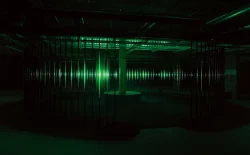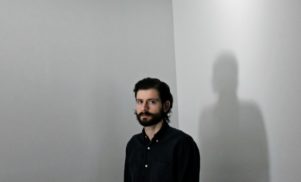Evan Caminiti first came to wider attention thanks to his partnership with Jon Porras in Bay Area band Barn Owl, initially one of the loudest, most overwhelming explorations on guitar drone rampage in the 21st century.
I once described them as creating ‘black walls of sound’ and that’s as accurate as anything else. As time went on, both in their work as Barn Owl and in their own solo releases, Caminiti and Porras demonstrated that psychedelic guitars weren’t all they could do, incorporating other instrumentation and approaches as they went.
For his latest solo release, Meridian, out on Thrill Jockey June 16, Caminiti explores modular synthesizer in particular, creating a series of pieces that apply his often cryptic and moody atmospheres to a very different approach than where he started. It’s a fine effort, not only when it comes to working in what’s become a rampantly popular field, but as a further stretching of his own abilities.
Reached by phone a few days before appearing on a hands-down killer bill with GABI and Holly Herndon in his new home base, New York City, Caminiti was his usual engaging self, quick and thoughtful in equal measure.
Barn Owl had, initially, walls of guitar and all that, but electronics started to appear in more recent releases, and of course you’ve been experimenting away. Is this release a more transitional work? How would you see it?
I think we’ve been moving toward electronics in the past few years and incorporating them more and more. I think mainly it has to do with, after so many years of really releasing a ton of records – I mean, over a dozen records based around guitar – I felt like I didn’t really have anything I wanted to say with the guitar, and it felt limiting rather than inspiring. I got to a point where I was running it through so many effects pedals that it was basically not even a guitar anymore. So it made me rethink my relationship with electronics. With my last two solo albums before Meridian, I got heavily into processing and using a cassette four-track to do a lot of tape processing, then re-amping the cassette recording through an amp and re-recording it, just trying all kinds of techniques around that. That processing took more of a forefront, rather than this idea of capturing a live moment occurring in a room.
Was it a matter of fine-tuning the recordings as you developed and built them up, or did pieces come together quickly?
There was definitely a little bit of both happening but I was very selective, and sculpted the album over a long period of time where I had just hours and hours of material that I had recorded over years. I really just picked the parts from these sessions that really resonated, and chopped up those parts. There was lots of post-production that went on. I’d say that I’m really rooted in this approach of creating something live, and I like that with my current electronic setup I can create sound in a live way. It’s not just digital multitracking, where you’re putting pieces together. It feels like you’re really playing something.
What is your setup at this point, in terms of recording?
Everything on this record is really based around a modular synthesizer. My interest was piqued a few years ago — you’re starting to hear more about modular synthesizers, these companies cropping up all over America, Europe, and the possibilities of modular synthesizers have really expanded within the last few years, where you really have a lot of digital stuff. People associate it as this temperamental analog equipment, but you really have a lot of flexible, practical tools that you can use, and you can mix and match them in a way that works for you and create your own unique instrument out of it. So that was really appealing.
This bleeds into a question not only about recording but performance. Every time I saw Barn Owl in the past, there was very much the sense of something tactile about the music, like a big wallop of an impact. Do you find yourself trying to recreate that?
One of the reasons that I really got into electronics was when we began using them live, it was a really different experience, where you have this epic arsenal of this frequency range that you don’t have with the guitar. It was inspiring. So bringing back that energy and thinking about the way that this sounded live, where the bass is rumbling throughout the whole body, it’s a really physical experience – so you’re not just listening, you’re feeling the music as well. That’s a hard thing for people to recreate in a home listening experience. I think it’s also the kind of thing where there’s enough detail going on that it’s still enjoyable just in headphones, but bringing on that really physical element adds a whole other dimension to the music that I personally really gravitate towards.
“People don’t think of electronic music as like playing a guitar, where you have to sit down and practice”
You were talking about the return of modular synths in recent years. There are all sorts of retrowave experiments out there now, sometimes very good, like Perturbator and others besides. Is there a danger of getting lost in the new crowd? Or is it just simply, “Hey, these are the times and this is the interest and this is what’s happening”?
Some people have a really negative reaction to [modular synthesisers], which I don’t really understand. Maybe they think it’s a fad because it’s impractical to them. And that’s a legitimate criticism, but when you compare it to old Moogs or Buchlas it’s really a lot cheaper. What I like about it is that you can customize it so heavily that you’re not necessarily rehashing some sort of vintage sound. There’s not this kind of nostalgia element, necessarily. You can sculpt very new, fresh sounds that have not necessarily been heard before, or sounds that mimic naturally occurring sounds, like water droplets, for example.
It allows you a lot of freedom, so you don’t necessarily get stuck in this sound where it’s just kind of blending in. [I’m] figuring out how to make it sound the way I want it to and not just like some Tangerine Dream sequencer running through this classic synth sound. I think I gravitated toward patching it up in ways where it doesn’t necessarily even sound immediately like a synthesizer. It’s not this really obvious, classic synth sound. You can really get pretty far out with it.
Does a particular sound get stuck in your head? What, at base, can provide a song?
It’s a good question. I feel like there’s a natural evolution of patching up a synth. Sometimes you’ll arrive at something that immediately clicks. Sometimes you’ll be refining for days, trying out what feels like infinite possibilities. But somehow it’s still a little more limiting than using something like software, where it’s like, wow, you can almost literally do anything with software. [The synth] is this insanely flexible tool that has this tactile element where you are limited by the hardware that you can touch and feel, and the different plugs that you can put the jack into. So you’re given certain constraints, but you can still do a ton with it, so it’s a really interesting way to be creative, and it’s almost like a puzzle that you slowly put together.
It’s super-easy to veer off course and spend hours going down the rabbit hole. It is important to have the sound that you want to hear, and keep in the back of your head the goal that you’re going for, which I think is usually a subconscious thing for me. So I think it naturally unfolds over time. But I had to spend some time to really make that relationship with a machine a smooth process, so it wasn’t strained, but that it was this seamless dialogue. It takes time and practice. People don’t think of electronic music, necessarily, as like playing a guitar, where you have to sit down and practice. But it really is this form of artistry and this discipline in and of itself.
What prompted the particular song titles on this release? The emphasis seems to be scientific and cartographic, for lack of a better term.
I think in the past I’d always gravitated towards a lot of imagery invoking these sort of specific moods, and setting up a context for a listener. And I think going with these really brief, concise titles mirrored the way that the music was made, where I was sitting down without expectations and seeing what came of it. There wasn’t this idea of a specific, “I want you to feel like you’re in this place.” It was more the daily practice of sitting down and making music and seeing what happens. Throwing in words that made sense in the context of the sounds, just to give the listener a brief point to jump in, but really allowed them the room to go where they want with it.
The press announcement mentioned an interest about doing some solo shows. How are you planning on staging and presenting that? I’m guessing it won’t just simply be “play the album,” or play songs from the album, but something else.
Yeah. It’ll be more like variations of songs on the album, because I’m going to be playing all live electronics rather than having a laptop to exactly recreate what you’re hearing on the album. Because I really love leaving things slightly open-ended live, and using the energy of improvising is important to me. Leaving room to evolve in a natural way, and this element of risk that is more exciting than going up and performing with a laptop, for me.
Finally, what prompted the move from the Bay Area to New York?
It was really just time for a change after about a decade there. Something that my partner and I have been wanting to do for a while. San Francisco also just changed enormously over the last few years, and it feels like an absolutely different place from when we first moved there. We were just ready for a change, and having grown up in California, having grown up on the West Coast, it felt like the time to do it was now. So we just took the dive in!






























